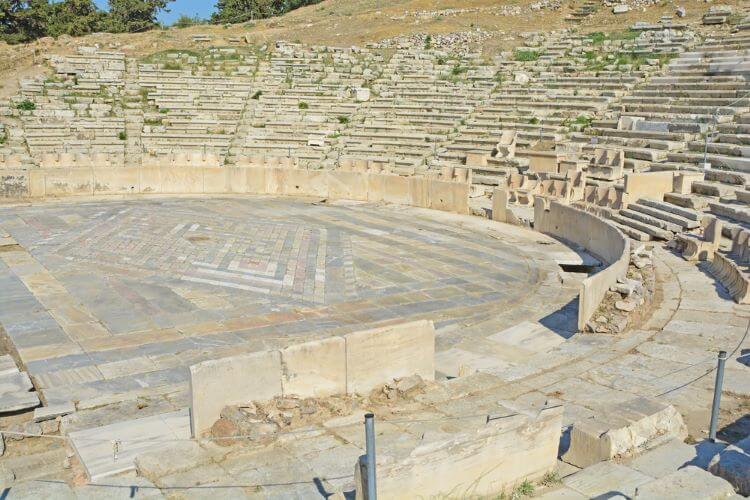Ancient ruins are scattered all over Athens, so how do you know which are the best Athens ruins to visit? In this complete guide, you’ll not only have all the practical info you need to visit the best Athens ruins but also why they are so important to Greece and to Western civilization. If you’re fascinated by ancient history and ancient Greece, don’t miss this comprehensive guide to the best Athens ruins to visit on your next visit to the Greek capital.
Acropolis of Athens
The UNESCO World Heritage Site, the Acropolis of Athens, is the most important historical site in Greece and its ancient ruins are among the most treasured in the world.

UNESCO describes the Acropolis as
“the greatest architectural and artistic complex bequeathed by Greek Antiquity to the world.”
Beginning in the fifth century BCE, the rocky hill towering over Athens became home to the Parthenon, Erechtheion, Propylaea, and Temple of Athena Nike.
Whilst the main Acropolis buildings date back to the 5th century BCE, the ancient citadel has been fortified by steep walls for over 3300 years and is a memorial to the thought and art of classical Western civilization including Democracy and Athenian philosophy.
Make sure that when you stay in Athens, you wake up with a spectacular view of the Acropolis, and watch it light up the Athens sky as night falls by staying in one of the Best Athens Hotels Near the Acropolis.
Propylaea

A Propylaea is an ancient Greek entranceway and the Acropolis Propylaea is the grandest in all of Greece.
The central gateway was the end of the Sacred Way which ran from Eleusis to the Acropolis.
The building is made from marble and plans had been made for northern and southern wings.
The outbreak of war between Athens and Sparta (the Peloponnesian War) in 431 BCE meant that the Propylaea was never finished.
Parthenon
I was so excited to see the Parthenon, I almost ran along the great marble slabs of the Propylaea and up the slight slope to its imposing form.

This Parthenon was constructed from 447 to 438 BCE and has been blown up, fired upon, looted, and turned into a site for the worship of Hagia Sophia, then the Virgin Mary, and then made into a mosque.
It is the third Parthenon to exist on the site but is perhaps the most magnificent.
Commissioned by Pericles and designed by Iktinos, the Parthenon is a double Doric column pavilion. The large wing has eight columns across its narrow side and 17 on its longest side.
Phidias was the sculptor of the Parthenon’s treasures. This would have included the ivory statue of Athena the Virgin, clad in armor, that once existed within the Parthenon.
It was stolen to Constantinople and eventually destroyed.
It’s not possible to enter the Parthenon but it is possible to see the friezes and pediments (mostly replicas) and to walk around the monument.
But you won’t be disappointed – it’s a real buzz to see this incredibly important world monument.
Erechtheion
The Erechtheion is, for me, as incredible as the Parthenon. It doesn’t have the scale of the Parthenon but it is the most significant in terms of the mythology of Ancient Greece.

The Erechtheion is dedicated to the god and goddess that fought for the hearts and minds of the people who became known as Athenians. The goddess Athena was chosen over the god of the sea, Poseidon.
The Erechtheion bears the scars of the mythological battle between the two gods. The hole in the roof of the Erechtheion is where Poseidon’s trident flew to earth, striking the ground, leaving deep scratches as well as a saltwater well to appear.
The sacred olive tree beside the Erectheion grew to symbolize the goddess Athena’s victory over Poseidon.
The Erechtheion also contains the “Porch of the Maidens,” the six Caryatids or draped female figures which are the columns supporting the roof.
Temple of Athena Nike
The Temple of Athena Nike is devoted to one of the three forms of the goddess Athena, all of which can be seen at the Acropolis.
(The other two are Athena Polonia, the goddess of the City, and Athena Promachos, the goddess of war).

The initial Temple of Athena Nike was demolished by the Turks in 1686 and later rebuilt. It is a four-column (tetrastyle) Ionic building.
At the Acropolis Museum, you can see a wonderful frieze from the pediment of the Temple showing Nike pausing to adjust her sandal.
It’s disappointing that it’s not possible to get close to the Temple of Athena Nike because it perches on the Propylaea, jutting out from the southeast entrance.
To enter the Temple of Victory (Nike means victory), you need to use a narrow stairway at the north of the Propylaea.
Odeon of Herodotus Atticus
Like the Arch of Hadrian, The ruins of the Odeon of Herodotus Atticus are not an ancient Greek monument, but in fact a Roman one.

It was built during the Roman period in 161 AD and is on the southwestern slope of the Acropolis. Originally it had a cedar roof.
It had been built by Herodotus (or Herodes) Atticus in memory of his wife. in 267 AD it was destroyed by the Heruli and finally renovated in the 1950s.
Today you can watch concerts here in the summer.
Theatre of Dionysus
The Theater of Dionysus is a must-see part of any visit to the Acropolis.
It is part of a Sanctuary of Dionysus on the southern slope of the Acropolis and was built in the sixth century BC.

This Theater is the birthplace of Western theater and was enormously important to Greek culture.
It was the performance space for great Ancient Greek tragedians and dramatists such as Aeschylus, Sophocles, Aristophanes, and Euripides.
Temple of Olympian Zeus
This ancient temple in the foreground of the Acropolis is dedicated to Zeus in his guise as the head of the Olympian gods.

Begun in the 6th century BCE, the Temple wasn’t completed until the Roman era. During this period it must have been a magnificent site with 104 columns and a giant cult statue.
But its full glory only lasted about 100 years. Because the Temple of Zeus was built during the time known as Athenian tyranny, the Temple was not completed once Athenian democracy had been restored.
Aristotle wrote that it was an example of a dictatorial white elephant project.
Today 16 of the giant columns still exist, the rest having been used for other buildings after the sacking of the building by barbarians in 267 AD.
Ancient Agora of Athens
The Classical Agora sits between the Acropolis and Market Hill (and not be confused with the Roman Agora).

It is the best example of an ancient Greek market. A large number of buildings were added to the site of the Agora, including the Stoa of Attalos and the Temple of Hephaestus.
Dating from the 6th century, of all the ancient sites in Athens, this is less imposing but was the center of everyday life in ancient Athens – a place for commerce, politics, and community.
Stoa of Attalos
This lovely building was a gift from King Attalos II of Pergamon to the city of Athens for the education it gave his son.

There are two reasons to seek out the Stoa of Attalos. The first is because it is a beautiful building and one of the few reconstructed from the Classical Era.
The reconstruction included as much of the original two-storied columned walkway as possible.
The second reason to visit is that the Museum of the Ancient Agora is located within the Stoa of Attalos.
It’s more than just a collection of finds from the Agora – these articles are central to Greek democracy, law, politics, and commerce.
The Museum includes official bronze stations, court plates, and court votes, as well as public clay measures, a clay hourglass, and even a lottery section made from marble!
Temple of Hephaestus
Unlike the Stoa of Attalos which has been reconstructed, the Temple of Hephaestus is the best-preserved ancient temple in all of Greece.

It is almost completely intact, even though it was built in 449 BCE.
The Temple is dedicated to the god Hephaestus, the god of fire, metalworking, and craftmanship. There are 6 columns on the east and west sides of the Temple and 13 on the longer sides.
It once contained statues of Athena and Hephaestus.
Kerameikos
Not as well known as other famous ruins in Athens, Kerameikos is, however, truly fascinating.

Kerameikos is also known as “ceramicus” in Latin which is where we get the word ‘ceramic.’ Inside the city walls is the Potters’ quarter.
Through the Dipylon Gate, the other part of Kerameikos is best known for the cemetery and the funerary sculptures that line the Sacred Way to Eleusis in Attica.
Given that there has been a cemetery in Kerameikos for 5000 years, it’s not surprising that the Kerameikos Museum has the best collection of burial artifacts in Greece.
Acropolis Museum
Many of the ancient ruins of Athens stand empty but it is possible to find some of the outstanding objects and works of art that belonged to them.

They exist here, in the New Acropolis Museum, close to the Acropolis, and an essential stop after the Acropolis.






![The Perfect Santorini Itinerary for 3 Days: Day-by-Day Plan with Local Tips [2025]](https://takemetogreece.com/wp-content/uploads/2024/04/Blue-domes-of-Santorini-Greece.jpg)

